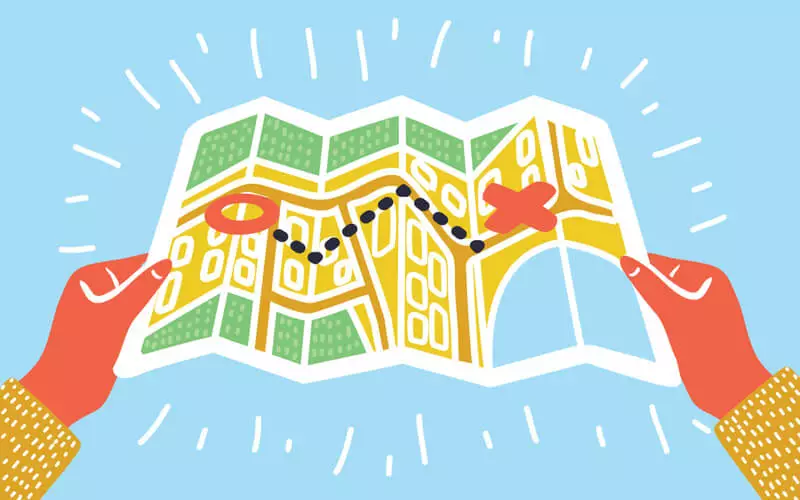A compelling customer experience is one of the most important competitive differentiators a company can have.
The customer experience has a powerful influence on everything from brand perception to customer retention. But before you can successfully provide a positive experience, you must understand what it’s like to go through the customer journey.
Customer journey mapping allows business leaders to understand what happens at each touchpoint, as well as the overall experience, to achieve more sales and customer satisfaction.
 Central to building an engaging customer experience is the ability to see from the customers’ perspective.
A customer journey map provides just this insight. From the initial contact stage through the process of engagement, the sale, and sustaining a long-term relationship, customer journey mapping provides an overview of the entire customer experience.
Assessing the customer journey helps you answer several important questions. For example, what are the motivations, experiences, and actions that drive customers to your business? What influences their decisions along the way?
If you can clearly answer these questions at each step of the journey, you are positioned to improve customer retention and satisfaction.
Central to building an engaging customer experience is the ability to see from the customers’ perspective.
A customer journey map provides just this insight. From the initial contact stage through the process of engagement, the sale, and sustaining a long-term relationship, customer journey mapping provides an overview of the entire customer experience.
Assessing the customer journey helps you answer several important questions. For example, what are the motivations, experiences, and actions that drive customers to your business? What influences their decisions along the way?
If you can clearly answer these questions at each step of the journey, you are positioned to improve customer retention and satisfaction.
 The discovery stage is critical for making a positive first impression and capturing your audience’s audience. The initial message of your product or service should be clear and concise, with little room for confusion.
The discovery stage is critical for making a positive first impression and capturing your audience’s audience. The initial message of your product or service should be clear and concise, with little room for confusion.
 Your website, which likely serves as the hub for your customer experience, should be welcoming, engaging, and easy to navigate. It should make customers want to keep clicking and exploring. Whether customers are browsing and unclear of their goal, or if they know exactly what they are looking for, the customer journey should satisfy a broad range of customer intentions.
Your website, which likely serves as the hub for your customer experience, should be welcoming, engaging, and easy to navigate. It should make customers want to keep clicking and exploring. Whether customers are browsing and unclear of their goal, or if they know exactly what they are looking for, the customer journey should satisfy a broad range of customer intentions.
 By the time a prospective customer reaches the selling stage, there should be no obstacle in his or her way. They should have access to all of the product information they desire, as well as support from sales reps.
If you detect a roadblock in the selling stage while customer journey mapping, this is a clear opportunity to improve.
By the time a prospective customer reaches the selling stage, there should be no obstacle in his or her way. They should have access to all of the product information they desire, as well as support from sales reps.
If you detect a roadblock in the selling stage while customer journey mapping, this is a clear opportunity to improve.
 Personalization is also key to long-term customer retention.
Personalization is also key to long-term customer retention.
 Customer journey mapping provides important insights into these questions, because they allow you to assess the entire customer experience piece by piece. You can have a great product or service, but if prospective customers find it impossible to access enough information, or if they get tripped up in the selling process, it will be difficult to establish a long-term customer relationship.
Customer journey mapping provides important insights into these questions, because they allow you to assess the entire customer experience piece by piece. You can have a great product or service, but if prospective customers find it impossible to access enough information, or if they get tripped up in the selling process, it will be difficult to establish a long-term customer relationship.
Dive Deeper: What Customer Experience Means For Brands in the Digital Age
Table of Contents
hide
What is customer journey mapping?
 Central to building an engaging customer experience is the ability to see from the customers’ perspective.
A customer journey map provides just this insight. From the initial contact stage through the process of engagement, the sale, and sustaining a long-term relationship, customer journey mapping provides an overview of the entire customer experience.
Assessing the customer journey helps you answer several important questions. For example, what are the motivations, experiences, and actions that drive customers to your business? What influences their decisions along the way?
If you can clearly answer these questions at each step of the journey, you are positioned to improve customer retention and satisfaction.
Central to building an engaging customer experience is the ability to see from the customers’ perspective.
A customer journey map provides just this insight. From the initial contact stage through the process of engagement, the sale, and sustaining a long-term relationship, customer journey mapping provides an overview of the entire customer experience.
Assessing the customer journey helps you answer several important questions. For example, what are the motivations, experiences, and actions that drive customers to your business? What influences their decisions along the way?
If you can clearly answer these questions at each step of the journey, you are positioned to improve customer retention and satisfaction.
5 stages of customer journey mapping
Customer journey mapping can be broken down into five main stages.Stage 1: Discovery
In the first stage, a customer either discovers some sort of marketing material or actively seeks out information about the product and service they are looking for. The discovery stage is critical for making a positive first impression and capturing your audience’s audience. The initial message of your product or service should be clear and concise, with little room for confusion.
The discovery stage is critical for making a positive first impression and capturing your audience’s audience. The initial message of your product or service should be clear and concise, with little room for confusion.
Stage 2: Engagement
Once customers arrive at your website, they should be met with straightforward but engaging user interface.Stage 3: Selling
The success of your selling stage is a clear indicator of what is working or not in your approach to customer experience. By the time a prospective customer reaches the selling stage, there should be no obstacle in his or her way. They should have access to all of the product information they desire, as well as support from sales reps.
If you detect a roadblock in the selling stage while customer journey mapping, this is a clear opportunity to improve.
By the time a prospective customer reaches the selling stage, there should be no obstacle in his or her way. They should have access to all of the product information they desire, as well as support from sales reps.
If you detect a roadblock in the selling stage while customer journey mapping, this is a clear opportunity to improve.
Stage 4: Personalized follow-up
After a sale, follow up with your customer about their experience using the product or service. This level of personalized communication shows your customers you value their business and opinions, and can also help you improve your customer support. Personalization is also key to long-term customer retention.
Personalization is also key to long-term customer retention.
Stage 5: Retention
The final step is when your audience decides to either stay and renew, up-sell or move to a different service or competitor.Provide a superior customer and never worry about competition again.
If you have high rates of customer turnover, it is important to explore why, how and where your audience is becoming disengaged or dissatisfied. Customer journey mapping provides important insights into these questions, because they allow you to assess the entire customer experience piece by piece. You can have a great product or service, but if prospective customers find it impossible to access enough information, or if they get tripped up in the selling process, it will be difficult to establish a long-term customer relationship.
Customer journey mapping provides important insights into these questions, because they allow you to assess the entire customer experience piece by piece. You can have a great product or service, but if prospective customers find it impossible to access enough information, or if they get tripped up in the selling process, it will be difficult to establish a long-term customer relationship.

